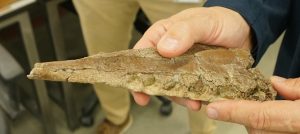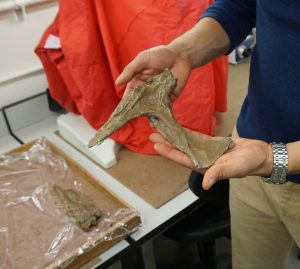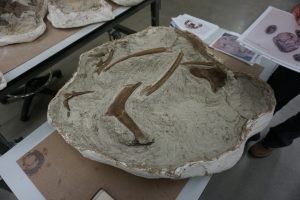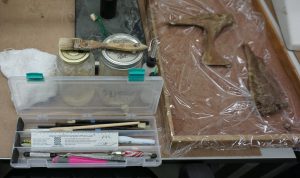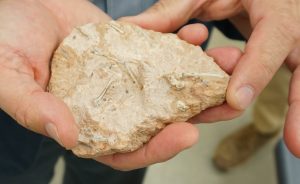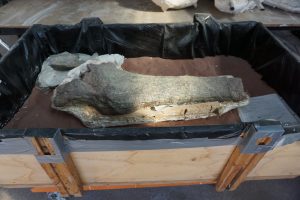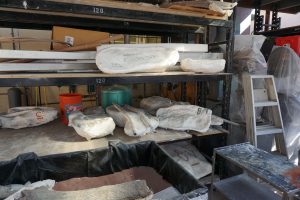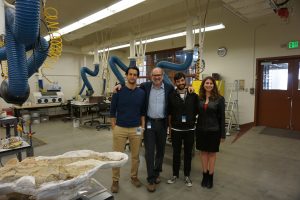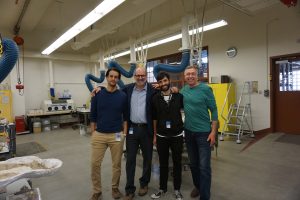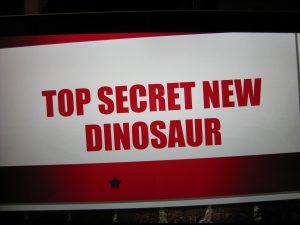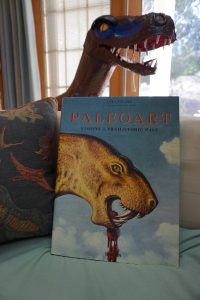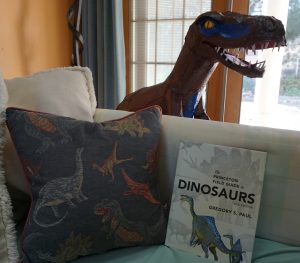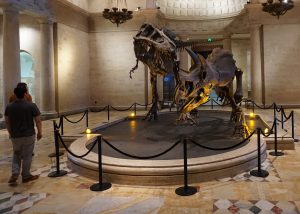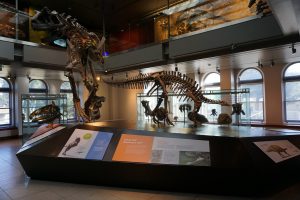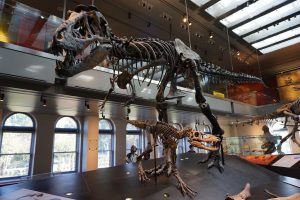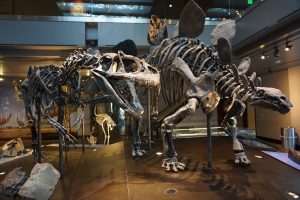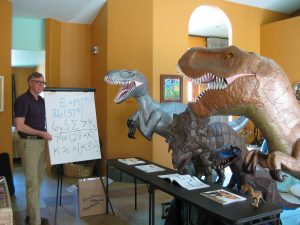Last Monday I was invited to lunch at the Dinosaur Institute with Dr. Luis Chiappe, Senior Vice President Research & Collections and Cristina Rosales, Fellows Membership Coordinator. It was a great opportunity to learn about the museums expeditions, resource library and tour the renovated new lab. My first visit to the lab was April 20, 2017 (see post 4/28/2017 “Natural History Museum LA – Meet Nate a Paleontologist!”). Renovations had just begun. So, I was very excited for a return visit to see the completion. The new Lab will allow for increased productivity while maintaining high quality standards. In addition to state of the art instrumental the new Lab provides the team adaptability of the space. It can accommodate specimens from a long-necked dinosaur to the most delicate microfossils.
Dr. Luis Chiappe holds the jaw of a member of the tyrannosaur family. Jose Soler, Paleontological Preparator holds another piece of this dinosaur that he has cleaned up very nicely. Many more fossils of this little guy are still in the stone. As you can see by all the scraping, it is an extremely time intensive process to separate the fossils from the surrounding stone.
Some of the tools will look familiar to you if you have ever been to a Dentist. As a Dentist uses these fine tools to clean your teeth, Paleontologists use them for detailed work with fossils. A great deal of care is required too! Dr. Luis Chiappe holds a fossil containing very tiny bones of a bird. Jose Soler has been working patiently to expose these delicate bones in the rock and will eventually separate them completely.
Pedro Mocho Lopes, PHD joins us to reveal a sauropod (long necked plant eating dinosaur) fossil which has a touch of green. More specimens of this sauropod and other dinosaurs are still in plaster casts on the shelves in the background. Each has a code to indicate the site originated. For example, the one on the top shelf the NM part of the code indicates a New Mexico site. Dr. Pedro Lopes is a sauropod expert and will be assisting me with specifications for an Amargasaurus. I’m planning on the addition of a “Full Size” Amargasaurus to PaulsPrehistoricPark.com. Can you image a 30-foot-long Metal Sculpture of an Amargasaurus! I can and it will be worth the wait! Much more to be revealed on that project later this year.
The group was kind to pose for a couple of photos. First photo left to right – Jose Soler, Dr. Luis Chiappe, Dr. Pedro Lopes and Cristina Rosales. Second photo left to right – Jose Soler, Dr. Luis Chiappe, Dr. Pedro Lopes and me Paul Heinzman. The blue flexible tubing hanging from the ceiling (visible in the group photos) are vacuum hoses to remove the dust created while separating the fossils from the rock. The air pressure hoses (the spiral yellow tubing hanging from the ceiling) provide for special tool attachments. Against the far left wall in the background is a piece of equipment for sandblasting smaller pieces. What appear as black circles are gloves for handling the pieces inside the box.
In the April 28, 2017 post we discussed Tawa Hallae, the Dinosaur Family Tree (which is discussed in further detail in the May 12, 2017 part 2 post) and a new Top Secret Dinosaur. Dr. Nate Smith who we met last April, had just returned from a dig in Antarctica the day of the luncheon. Cristina and I were able to pop in for a quick Hi. Nate indicated the Top Secret Dinosaur is still Top Secret pending publishing the study. He collected many fossils while in Antarctica. Looking forward to new discoveries from Nate’s recent travels to be reveal in future posts.
During our lunch Dr. Luis Chiappe recommended a great book – “PALEOART Visions of the Prehistoric Past” by Zoe Lescaze with a preface by Walton Ford. I found it on Amazon.com for 25% off. It’s a fantastic book with artwork from the early 19th Century to the digital age. It’s 292 big 11” x 14.7” pages with 4 that fold out 4 pages wide! The artists are from the US, Europe and Russia. The different styles and imaginings of Dinosaurs across time and countries is really wonderful. I must admit I looked at all the pictures first! I now must start over and read the text this time. A more detailed review to come.
I purchased another book at the same time through Amazon “The Princeton Field Guide to Dinosaurs” 2nd Edition by Gregory S. Paul. This book provides illustrations for how to add musculature to bone. It looks very promising to assist me with creating drawings for metal sculpture artists to build new Dinosaurs for the Park. It will definitely help with my Amargasaurus Project. Look for a review of this book in a future post, as well.
I was given a preview of the new NHMLA journeys program. A more detailed presentation is scheduled in March. The destination is Spain from Prehistory to Picasso. The rich paleontological heritage of dinosaur research combined with food, art and music that make up Spain’s lush and complex culture. I’m looking forward to sharing more on this event too!
Note: This program is for Fellows Membership and above. For more details about memberships go to www.nhm.org click on the Join Us tab, select Membership, then Levels Benefits in the drop-down menus to see which one is best for you. For more information about the Fellows Membership call Cristina Rosales (213) 763-3253.
Before leaving I had to visit Dinosaur Hall. It’s always a place for inspiration and amazement.
More on Pamela the Pachycephalosaurus makeover coming soon. Many Paleoartists illustrate the Pachycephalosaurus with small horns on the top edges of the neck, back and tail. Pamela came with the typical horns on the head only. Paint can create the illusion of horns in these areas. l will show you how to make templates for painting horns of various sizes and angles on the neck, body and tail. Then it will be time for Pamela’s finishing act with clear coating!
“Encouraging the Appreciation of Art and Education through the Inspiration of Dinosaurs”
Paul & Prehistoric Pals
Your feedback is appreciated, Thank you!
